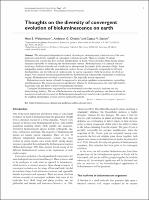Please use this identifier to cite or link to this item:
https://hdl.handle.net/20.500.12202/9615Full metadata record
| DC Field | Value | Language |
|---|---|---|
| dc.contributor.author | Oliveira, Anderson G. | - |
| dc.contributor.author | Waldenmaier, Hans E. | - |
| dc.contributor.author | Stevani, Cassius V. | - |
| dc.date.accessioned | 2023-12-08T17:27:23Z | - |
| dc.date.available | 2023-12-08T17:27:23Z | - |
| dc.date.issued | 2012-05-02 | - |
| dc.identifier.citation | Waldenmaier, H., Oliveira, A., & Stevani, C. (2012). Thoughts on the diversity of convergent evolution of bioluminescence on earth. International Journal of Astrobiology, 11(4), 335-343. doi:10.1017/S1473550412000146 | en_US |
| dc.identifier.issn | 1473-5504, 1475-3006. | - |
| dc.identifier.uri | https://hdl.handle.net/20.500.12202/9615 | - |
| dc.description | Scholarly article / OA | en_US |
| dc.description.abstract | The widespread independent evolution of analogous bioluminescent systems is one of the most impressive and diverse examples of convergent evolution on earth. There are roughly 30 extant bioluminescent systems that have evolved independently on Earth, with each system likely having unique enzymes responsible for catalysing the bioluminescent reaction. Bioluminescence is a chemical reaction involving a luciferin molecule and a luciferase or photoprotein that results in the emission of light. Some independent systems utilize the same luciferin, such as the use of tetrapyrrolic compounds by krill and dinoflagellates, and the wide use of coelenterazine by marine organisms, while the enzymes involved are unique. One common thread among all the different bioluminescent systems is the requirement of molecular oxygen. Bioluminescence is found in most forms of life, especially marine organisms. Bioluminescence in known to benefit the organism by: attraction, repulsion, communication, camouflage, and illumination. The marine ecosystem is significantly affected by bioluminescence, the only light found in the pelagic zone and below is from bioluminescent organisms. Transgenic bioluminescent organisms have revolutionized molecular research, medicine and the biotechnology industry. The use of bioluminescence in studying molecular pathways and disease allows for non-invasive and real-time analysis. Bioluminescence-based assays have been developed for several analytes by coupling luminescence to many enzyme-catalysed reactions. | en_US |
| dc.language.iso | en_US | en_US |
| dc.publisher | Cambridge UP | en_US |
| dc.relation.ispartofseries | International Journal of Astrobiology;11(4) | - |
| dc.rights | Attribution-NonCommercial-NoDerivs 3.0 United States | * |
| dc.rights.uri | http://creativecommons.org/licenses/by-nc-nd/3.0/us/ | * |
| dc.subject | bioluminescence | en_US |
| dc.subject | dioxetanone | en_US |
| dc.subject | Luciferase | en_US |
| dc.subject | luciferin | en_US |
| dc.subject | photoproteins | en_US |
| dc.title | Thoughts on the diversity of convergent evolution of bioluminescence on earth | en_US |
| dc.type | Article | en_US |
| dc.identifier.doi | https://doi.org/10.1017/S1473550412000146 | en_US |
| dc.contributor.orcid | 0000-0003-1752-0726 | en_US |
| local.yu.facultypage | https://www.yu.edu/faculty/pages/oliveira-anderson | en_US |
| Appears in Collections: | Stern College for Women -- Faculty Publications | |
Files in This Item:
| File | Description | Size | Format | |
|---|---|---|---|---|
| Oliveira 2012 OA Thoughts_on_the_diversity_of_convergent.pdf | 318.88 kB | Adobe PDF |  View/Open |
This item is licensed under a Creative Commons License

